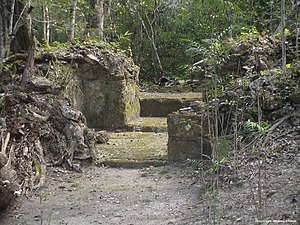 Image via Wikipedia
Image via WikipediaThe Maya: Glory and Ruin
Saga of a civilization in three parts: The rise, the monumental splendor, and the collapse.
Photograph by Simon Norfolk with permission of Conaculta-INAH, Mexico
The doomed splendor of the Maya unfolded against the backdrop of the rain forests of southern Mexico and Central America. Here, Classic Maya civilization reached improbable heights. To chart a culture whose Preclassic roots reach back 3,000 years, we begin with new evidence suggesting that the arrival of a warlord from central Mexico ushered in an age of magnificence and masterpieces such as the death mask of Palenque's King Pakal. But empires rise only to fall. We conclude with the cascade of catastrophe—natural and man-made—that precipitated the Classic Maya collapse, leaving nature to reclaim the grandeur.
THE RISE
The Kingmaker
The stranger arrived as the dry season began to harden the jungle paths, allowing armies to pass. Flanked by his warriors, he marched into the Maya city of Waka, past temples and markets and across broad plazas. Its citizens must have gaped, impressed not just by the show of force but also by the men's extravagant feathered headdresses, javelins, and mirrored shields—the regalia of a distant imperial city.
Ancient inscriptions give the date as January 8, 378, and the stranger's name as Fire Is Born. He arrived in Waka, in present-day Guatemala, as an envoy from a great power in the highlands of Mexico. In the coming decades, his name would appear on monuments all across the territory of the Maya, the jungle civilization of Mesoamerica. And in his wake, the Maya reached an apogee that lasted five centuries.
THE RISE
The Kingmaker
The stranger arrived as the dry season began to harden the jungle paths, allowing armies to pass. Flanked by his warriors, he marched into the Maya city of Waka, past temples and markets and across broad plazas. Its citizens must have gaped, impressed not just by the show of force but also by the men's extravagant feathered headdresses, javelins, and mirrored shields—the regalia of a distant imperial city.
Ancient inscriptions give the date as January 8, 378, and the stranger's name as Fire Is Born. He arrived in Waka, in present-day Guatemala, as an envoy from a great power in the highlands of Mexico. In the coming decades, his name would appear on monuments all across the territory of the Maya, the jungle civilization of Mesoamerica. And in his wake, the Maya reached an apogee that lasted five centuries.
The Maya have always been an enigma. Decades ago the glories of their ruined cities and their beautiful but undeciphered script had many researchers imagining a gentle society of priests and scribes. As epigraphers finally learned to read the Maya glyphs, a darker picture emerged, of warring dynasties, court rivalries, and palaces put to the torch. Maya history became a tapestry of precise dates and vividly named personages.
But deep mysteries remained, among them what spurred the Maya's final leap toward greatness. Around the time Fire Is Born's fame was spreading, a wave of change swept the Maya world. What had been a collection of inward-looking city-states expanded their ties with their neighbors and other cultures and reached the heights of artistic achievement that define the Classic Maya period.
New clues, unearthed from overgrown ruins and teased from newly deciphered texts, point to Fire Is Born as a central figure in this transformation. Though fragmentary, the evidence that has emerged over the past decade suggests that this mysterious outsider remade the political leadership of the Maya world. Mixing diplomacy and force, he forged alliances, installed new dynasties, and spread the influence of the distant city-state he represented, the great metropolis of Teotihuacan near present-day Mexico City.
Scholars disagree about the nature of his legacy—whether he ushered in a lasting era of foreign domination or catalyzed homegrown change. It is also possible that the Maya were already destined for greatness, and Fire Is Born just picked a lucky time to visit. But there is no question that his arrival marked a turning point. "I don't know if Fire Is Born invented the new system," says Nikolai Grube of the University of Bonn, "but he was there at the beginning."
Even before Fire is Born, the Maya had risen to unlikely heights in a harsh land. Today, the lowlands of southern Mexico and Guatemala's Petén region yield little beyond bare subsistence to their inhabitants. "A high civilization," says Vanderbilt University Maya scholar Arthur Demarest, "had no business being there."
The setting of ancient Waka, now known as El Perú, is probably much as it was when the first Maya arrived, in perhaps 1000 B.C.—a dense rain forest where scarlet macaws, toucans, and vultures nest in towering tropical hardwoods. Spider monkeys swing from branches and vines, and howler monkeys bellow in the distance. When it rains in the Petén, mosquitoes swarm in such clouds that today's Maya have to drive them away with greasy smoke from torches burning cohune palm nuts. In the dry season, the heat bakes the swampy bajos, or bottomlands, the rivers fall, and drought threatens. It is a land of machetes and mud, serpents and sweat, and cats—most notably balam, the jaguar, lord of the jungle.
source: nationalgeographic.com



0 comments:
Post a Comment